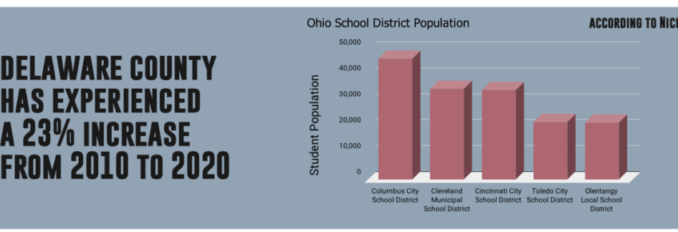
design & graphic: Wyatt Downey
Olentangy Local School District is the fifth largest in the state with 28 separate schools including the addition of a new middle school currently in the process of being built.
The area surrounding the district has grown immensely in the last 10 years. Delaware County is currently the fastest growing county in the state of Ohio, according to usa.com.
“Delaware County is seen as a desirable place to raise a family in a suburban setting with a relatively affordable housing market. The county has outstanding schools and an appealing rural environment with easy access to major retail and entertainment venues as well as a significant amount of green space and great system of public parks. The population of Delaware County has grown from 174,214 in 2010 to 214,124 based on the 2020 census, a 23 percent increase from the 2010 census,” Delaware County Auditor George Kaitsa said.
This growth has created the need for a large school district to support the ever-growing population.
“The population growth has resulted in the need for the construction of new school buildings, particularly within the Olentangy Local School District. The need for new school buildings has resulted in the need for a bond levy and several current expense levies to support the growth of the school district. Other school districts in the county have had the same experience,” Kaitsa said.
The building of these new school buildings led to another problem for the school district—attendance boundaries. Districts such as Olentangy are forced to update their attendance boundaries with the completion of each subsequent school building.
“Redistricting typically occurs when we open a new building which is currently happening in our district as we plan to open Berlin Middle School next year. We are also going to adjust some elementary boundaries as we have a couple of buildings that are significantly over capacity,” Olentangy Local School District Superintendent Mark Raiff said.
Redistricting can also be done periodically in between the construction of new school buildings when there are buildings in the district that are substantially over-capacity.
Raiff mentioned the need to redo boundaries when a school has too many students; he also explained that Olentangy has a capacity of 1100 for their middle schools and 750 for their elementary schools. With the current growth of the surrounding area, projections show the need for another middle school and three more elementary schools within the next 10 years.
The actual process of changing district boundaries can be difficult. Many different factors have to be considered.
“State law gives the superintendent the authority to assign staff and students in our district. I choose to use a process that gathers input and feedback from many community members. We have a consultant who helps manage the data that shows where every student lives and how moving students impacts the current and future enrollment at each school. We have a community committee that develops and analyzes a number of scenarios, gathers feedback from the community and makes a recommendation on potential boundaries. I ultimately make the final decision on the boundaries,” Raiff said.
Olentangy Local School District is currently the fifth largest school district in the state following the large urban school districts of Columbus, Cleveland, Cincinnati, and Toledo, and is still growing at a very quick pace.
“While the current growth may level off due to rising interest rates that affect the cost of financing the purchase of a home. I do not expect to see any decrease in the near future. In addition, the Intel facility in Licking County will create additional demand for housing in Delaware County as the Intel facility ramps up production,” Kaitsa said.
As long as the district keeps getting larger, the need to redistrict school attendance boundaries will always be there.


